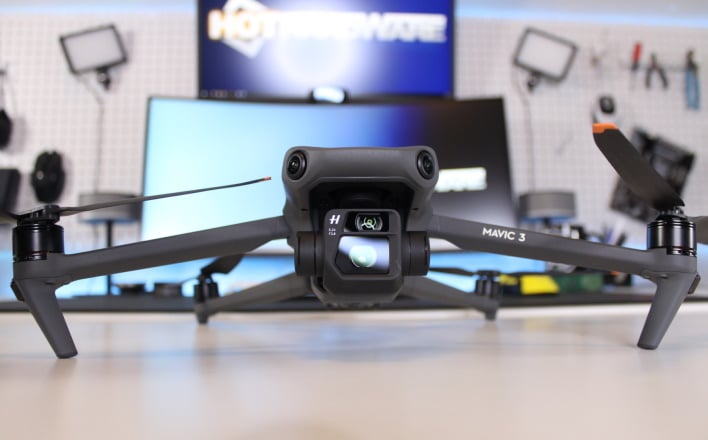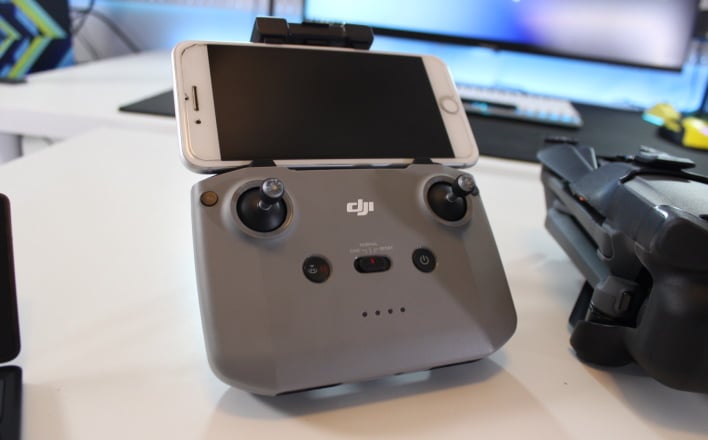DJI Mavic 3 Review: Did The Best Drone Get Even Better?
DJI's Mavic 3 Is An Amazingly Intelligent, Aerial Imaging Workhorse
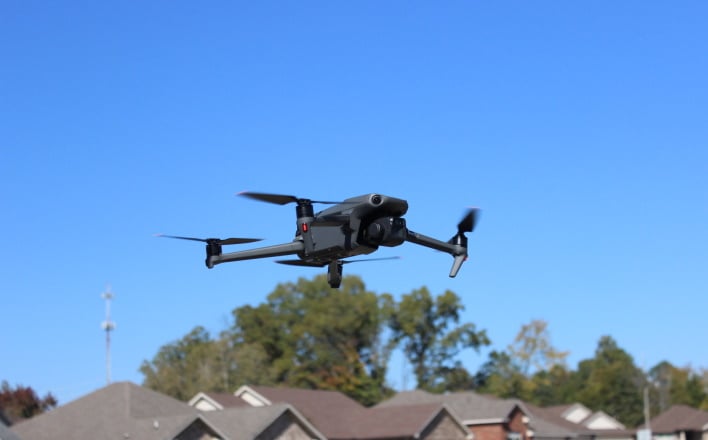
DJI's worst-kept secret has arrived. After months of extensive leaks, the new DJI Mavic 3 has landed (or taken off depending on your perspective).
DJI has advanced its done line-up significantly since introducing the first Mavic Pro back in 2016. The Mavic Pro line, including the upgraded Mavic 2 Pro, have been workhorses for those in the aerial photography and videography fields, while the Mavic Air line targeted consumers who craved a quality drone with good camera chops, but didn't quite want to jump into prosumer territory. We mention DJI's previous-gen products here hoping to avoid some confusion. With this latest drone carrying simple Mavic 3 branding -- sans Pro -- some may think the Mavic 3 is somehow lesser than its Pro-branded predecessors. Don't think that for one second, though. The Mavic 3 is a professional piece of kit through and through.
Sitting next to a Mavic Air 2 it's clear: The new Mavic 3 is bigger, faster, smarter and significantly more capable. And if you're still toting around a Mavic 2 Pro, but are looking for an upgrade, DJI may have enough on tap here to get your attention. There will be three different models of the Mavic 3 available, starting with the base model, then moving up to the upgraded "Fly More" package (that's the one we're looking at today), and finally the top-end "Cine" model. We'll touch on the Cine model a little later for the sake of clarity, but our focus here will be on the Mavic 3 Fly More bundle.

DJI has advanced its done line-up significantly since introducing the first Mavic Pro back in 2016. The Mavic Pro line, including the upgraded Mavic 2 Pro, have been workhorses for those in the aerial photography and videography fields, while the Mavic Air line targeted consumers who craved a quality drone with good camera chops, but didn't quite want to jump into prosumer territory. We mention DJI's previous-gen products here hoping to avoid some confusion. With this latest drone carrying simple Mavic 3 branding -- sans Pro -- some may think the Mavic 3 is somehow lesser than its Pro-branded predecessors. Don't think that for one second, though. The Mavic 3 is a professional piece of kit through and through.
Sitting next to a Mavic Air 2 it's clear: The new Mavic 3 is bigger, faster, smarter and significantly more capable. And if you're still toting around a Mavic 2 Pro, but are looking for an upgrade, DJI may have enough on tap here to get your attention. There will be three different models of the Mavic 3 available, starting with the base model, then moving up to the upgraded "Fly More" package (that's the one we're looking at today), and finally the top-end "Cine" model. We'll touch on the Cine model a little later for the sake of clarity, but our focus here will be on the Mavic 3 Fly More bundle.
Let's take you on a guided video tour and flight test with the Mavic 3 first, and then we'll circle back for more analysis of our experience with DJI's latest airborne beast...
DJI Mavic 3 Fly More: What's In The Box?
DJI includes a diverse array of parts and accessories in the box, but because of the Mavic 3's more streamlined design, it may not seem like a whole lot on the surface, especially considering the Fly More bundle's $800 price premium over the standard model. Obviously the kit includes the Mavic 3 and its companion remote, but that's a given. Also included are a ND filters that range from ND4 all the way up to ND32. These come in handy on bright filming days where you need to tone down the light, that can't be controlled with aperture alone. Then there is the convertible carrying case, which is a nice, rugged canvas on the outside with soft supple felt lining on the interior that keeps everything cushioned and snug. And, if you don't like the messenger bag configuration, it converts into a full-on backpack as well.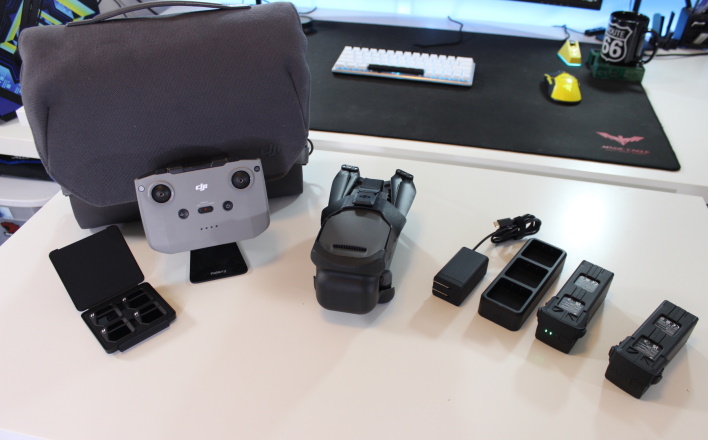
The Mavic 3 has a newly redesigned battery setup as well, which offers a massive step up in capacity. The old Mavic 2 uses 3850mAh 4 cell LiPo batteries, while these new batteries offer 5000mAh. The three included batteries no longer load into the top of the drone as we've become accustomed to either, but rather insert through the rear of the chassis. Along with the trio of batteries comes a triple battery charger, but there's a catch. The included charger doesn't charge all 3 batteries simultaneously, but rather one at a time in series until they're all topped up.
Inspecting The DJI Mavic 3
The Mavic 3 has what is essentially a totally new design, but it does borrow heavily from previous models and will seem familiar to anyone that's worked with any of the previous folding Mavic drones from DJI. The overall experience with the Mavic 3 is improved in our opinion, however. The Mavic 3 may look somewhat similar, but upon closer inspection, you'll find that virtually every aspect of the design has been enhanced or refined with improved usability and the end-user in mind. From the new easier-to-use and more protective 'muzzle' style brace that holds the camera in place alongside the props, so they're not swinging around in storage, to the legs that prevent the Mavic 3 from sitting directly on the ground, everything has been improved upon with this latest design.
DJI Mavic 3 Specifications & Features
| Aircraft: | Size: Folded (without propellers) 212mm x 96.3mm x 90.3mm / Unfolded 347.5mm x 283mm x 107.7mm |
| Speed: 46.9 mph max speed in Sport mode | |
| IR obstacle-sensing on all sides, APAS mode allows aircraft to avoid obstacles, auxiliary low-light bottom light to assist sensors | |
| Takeoff weight: 32 oz. | |
| Service ceiling: 3.7 miles above sea level | |
| Dual-system navigation: GPS and GLONASS | |
| Camera: | 3-axis gimbal |
| Autofocus with FOV: 24-48mm optical zoom | |
| Main: 4/3 CMOS sensor, Effective pixels: 20 MP, Tele: 1/2 inch CMOS | |
| Main: Aperture: f/2.8 to f/11, Tele Aperture: f/4.4 | |
| Shutter speed: 8-1/8000 | |
| Photo formats: JPEG and DNG (RAW) | |
| Video formats: MP4 / MOV (H.264, HEVC/H.265) Video Resolution And Frame Rate: 5K: 5120x2700 24/25/30/48/50p 4K: 3840×2160 24/25/30/60p FHD: 1920×1080 24/25/30/48/50/60/120p |
|
| ISO: 100 - 3200 (video), 100 - 1600 (photo, auto), 100 - 3200 (photo, manual) | |
| 100MP Panoramic View | |
| Dolly zoom and other specialty modes (see below) | |
| Image Storage: | Save to controller, SD card (up to 2TB, not included), or mobile device |
| Battery: | 5000 mAh, 46 minutes max flight time, weight: 335.5g. |
| Video Transmission: | 4.97 miles, with 1080p live video |
| 2.4/5.8 GHz, auto-switching | |
| 40 Mbps download speed | |
| 120ms latency | |
| Video Modes: | ActiveTrack 5.0: Tracks moving people and objects |
| Panoramas: 4 sub-modes: Sphere, 180, Horizontal, Vertical | |
| Quickshots: POI , Asteroid, Boomerang, Rocket, Dolly-Zoom | |
| Hyperlapse: Free, Dronie, Circle, Course Lock, Waypoint | |
| Price: | Mavic 3 Fly More Bundle: $2,999 At Amazon |
The Mavic 3 is larger than its predecessors. The Mavic 2's props measured in at 8.9", but the Mavic 3's are slightly larger at 9.1". Couple the larger props with the updated swing arm design and the Mavic 3 ends up being somewhat larger overall as well -- it measures about 25" across from prop-tip to prop-tip. The larger props and more angled-out design of the motors is more efficient as well, hence the Mavic 3's relatively long flight time over and above what comes by way of the higher-capacity battery, but they do increase the overall dimension of the drone.
The new design also affects noise output. The noise emitted from the Mavic 3 isn't quite as jarring as older designs and doesn't sound like a swarm of angry bees swirling overhead, but it's not particularly quiet either, so don't expect to be sneaking up on anyone with this drone.
The front camera assembly is massive due to housing two lens a couple of relatively large sensors, but the 3-axis gimbal keeps it stabilized and secure during transport like previous models. The arms for the motors and props are slimmer and more elegant than the older Mavics, but they're not flimsy at all and feel as rigid as they come. And they have to be now that the ends of the arms are the set points for the Mavic 3. No longer does the belly sit on the ground, a good move that should keep the bottom sensors nice and clean between landings and takeoffs.
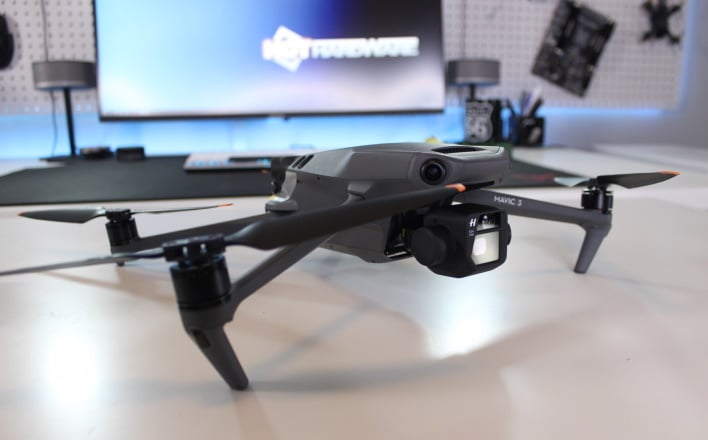
The rear of the Mavic 3 houses plenty of ventilation for the onboard flight controller's cooling fan. In fact, we have to mention that the Mavic 3 was always surprisingly cool to handle when it came back after long flights, which is not something we could say about the older Mavic drones. The power button is on the back, so you'll no longer have to push down on the drone to power it up. The rear is also where you'll be inserting and removing the new battery, with latches on the sides. Just above the battery port is the cover for the USB-C connection/charging port and the MicroSD slot that's compatible with cards up to a 2TB. While on the subject of MicroSD cards, opt for a high-speed V30 model -- the write speed requirements for 4K120 video are fairly demanding.
There are also an array of cameras on the back of the Mavic 3 for the APAS 5.0 omnidirectional obstacle avoidance, which allows the drone to react to dangers in all flight modes, except for sport mode. Use sport mode at your own risk, and preferably when you're at high enough altitude to not have to worry about obstacles. Other than that the backside of the Mavic 3 is relatively spartan.
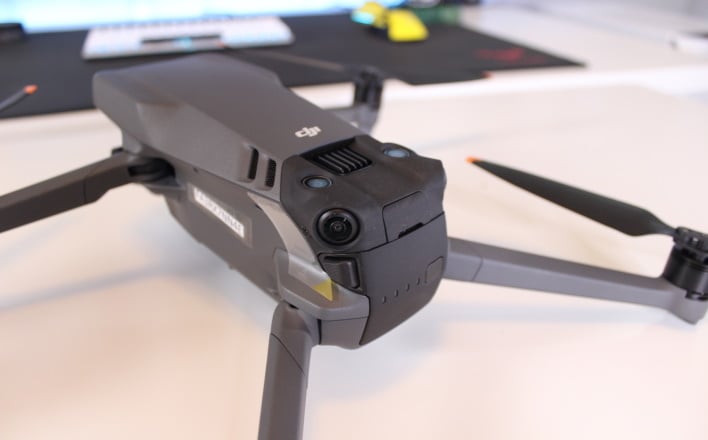
On the bottom of the drone, you'll find a couple of bumpers which protect the cameras. There are two cameras to be exact, used for measuring distances below the drone, which ensure smooth, soft landings when using the Return To Home feature. The Return To Home feature is something new and much more accurate than was anticipated. We tested it between two parked vehicles and found that it had zero issues returning to the exact take-off spot, despite us flying it miles away and zig-zagging back. There are also a pair of lights for increased visibility when it gets dark out.
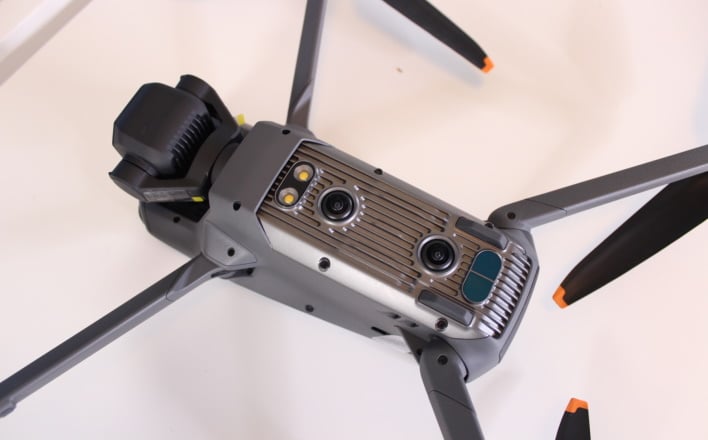
The DJI Mavic 3's Camera Upgrades
The DJI Mavic 3 is sports a dual-camera system, consisting of a 4/3 CMOS sensor with Hasselblad color science, capable of shooting 5.1K at 50 frames per second and 4K at 120 frames per second. The Hasselblad L2D-20c is the main camera, which features a 24mm lens with a wide f/2.8 -f/11 adjustable aperture. If you're willing to throw down on the Mavic 3 Cine this camera will also record using Apple ProRes, but expect to nearly double your investment for that capability.The second camera onboard has a Telephoto lens with a 28x Hybrid Zoom capability. This was a super useful feature when using the Mavic 3 for inspections or simply when needing to get a close-up shot of something that you simply can't fly close to. This lens has a 162mm focal length with a fixed aperture of f/4.4, and that's where those included ND filters really come into play since the main camera has quite a bit more wiggle room in terms of aperture adjustments.
Both cameras in single-shot picture mode delive 20 megapixel still images available in JPEG, RAW, or JPEG + RAW format.
The DJI Mavic 3 Controller
There's not much different about the Mavic 3's controller. If you're familiar with the controller that DJI has been using for its camera drones since the Mavic Air 2 then you're going to be familiar with the setup. There are a couple of changes regarding the buttons worth noting, however. The Return To Home button now has a dual function as both RTH but also 'pause', that will make the drone air brake and stop in its tracks. DJI also changed the name of the 'Tripod' setting to 'Cine'.The transmission range is still the same as before with the O2 frequency and we were able to fly over 2.5 miles without any issues. If we have anything to complain about it's that DJI hasn't made it any easier to mount your phone on this contraption.
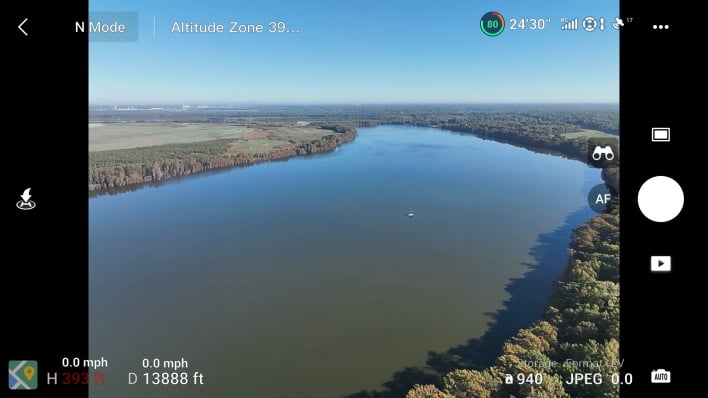
DJI Mavic 3 Flight Features & More
Gearing up for flight with the Mavic 3 is simple. Remove the 'muzzle', unfold the arms, power up the drone, strap your phone in to the radio controller, power it on, and you're ready to fly. If you've ever flown a DJI drone then you're going to feel right at home here, with everything reacting just as you're used to. However, if you've never flown one before, you're going to be in for a treat and finish up thinking you're a pro. Time to get that Part 107 license?In our experience, the claims regarding the Mavic 3 made by DJI during its launch event were spot on. Flight times surpassed the half hour mark. DJI claimed up to 46 minutes, but keep in mid, that's in 'ideal conditions and hovering' so over a half-hour maneuvering on a windy day was very nice.
Speeds were good as well with Sport mode topping out at 46 miles per hour, Normal mode cruising along at a brisk 22 miles per hour, and Cine mode slowing things down for those controlled pans and reveal shots.
We flew the Mavic 3 in a few different environments to see how the radio range was with transmission and are happy to report that it did very well. Even in a Wi-Fi polluted neighborhood, we were able to let it stretch its legs and fly well over a mile away before running into air space restriction issues. That brings up another very good point of the Mavic 3 and flight -- it helps keep you out of trouble. There are restrictions when you're flying any unmanned aircraft and they can be tricky to keep up with. Thankfully, DJI does a really good job keeping up with the latest restrictions and monitoring where you are at all times, so that you can avoid accidentally coming home with a massive fine from the FAA. There are people out there with concerns about the data being collected while flying, but there's a pretty good reason why it being done.
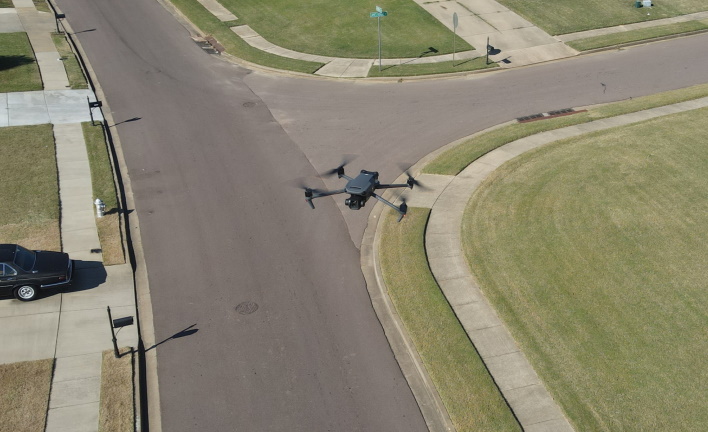
Many of the reviews you're going to see of the Mavic 3 are likely going to be showcasing dense urban areas, but we took it to the middle of nowhere. Actually, the shots from the Mighty Mississippi showcase a lot of what the drone is capable of doing for those looking to get 'the shot'. For example, the shot below was quite the fun journey for the Mavic 3 with it taking nearly a 3-mile journey across cotton fields and marshes to acquire a shot facing up river towards Memphis, TN. If you look way off in the center of the horizon you can catch a glimpse of the Memphis Pyramid 13 miles away. We were quite impressed. And when leaving, we let the Mavic 3 'chase' us as we escaped, and were quite surprised to see it dodge trees and other parked vehicles as we made our way to the car. Unfortunately, that's when we learned of the shortcomings of our slow MicroSD card, so the footage wasn't usable.
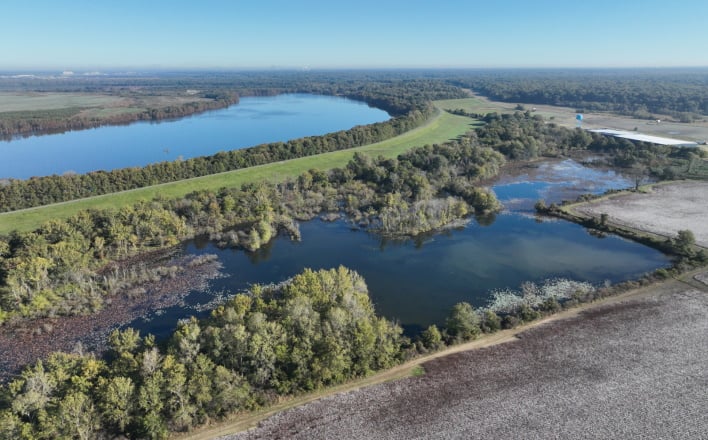
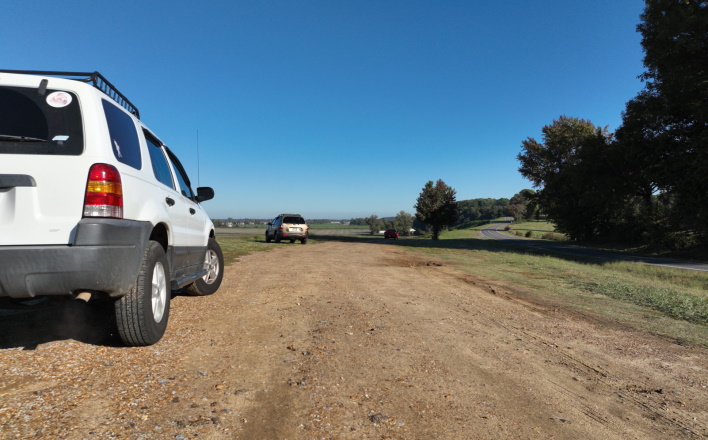
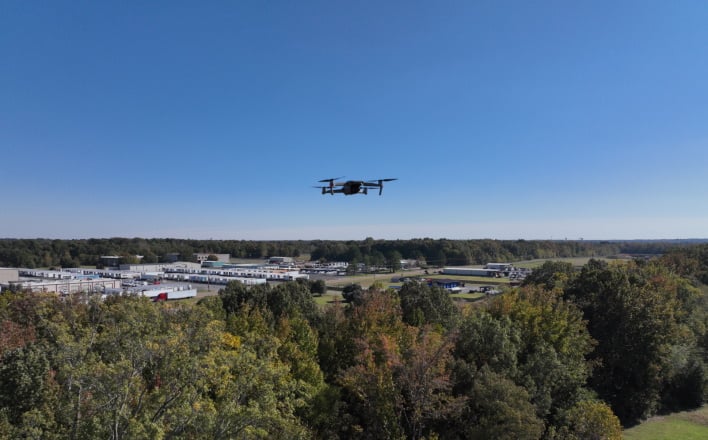
DJI Mavic 3: Semi-Final Thoughts
The DJI Mavic 3 Fly More bundle is exceptional. The build quality of the accessories is top-notch. The convertible bag nails it on two fronts, as a killer tote for those who want something smaller or as a comfortable backpack for those who need to carry a bit more kit. The included ND filters are great quality and you don't have to worry about fitment at all, as they're purpose built for the unit. Triple batteries and a multi-charger only sweeten the deal. The controller is still likely the weak point and is nothing to get excited about, but it gets the job done well. We just with the phone mount was a bit less cumbersome.The Mavic 3 is a clear upgrade over its predecessor. It seems almost every aspect of the drone has been upgraded. The Mavic 3 offers improved flight times, it has better build quality, and the dual camera setup is top notch. And all of this comes in an easy-to-use, novice-friendly, and professional package that will leave its owner feeling like they've made a worthwhile investment.
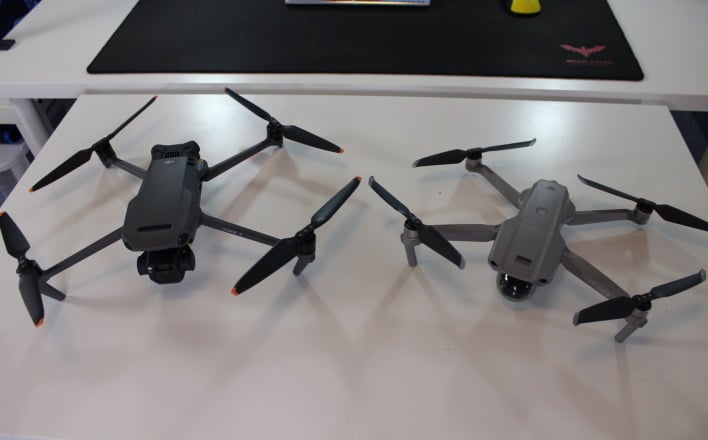
The DJI Mavic 3 does come at a considerable cost, however. The Standard version will set you back $2,199 while the Fly More package arrives at $2,999. The Cine model only ups the ante even further. The lack of a "Pro" moniker like previous gen model may confuse some consumer, but rest assured these drones are not meant for the hobby pilot who just wants a camera drone to capture the occasional landscape. Those consumers can certainly pick up a Mavic 3 and will likely have a wonderful time with it, but this model lands squarely in prosumer territory at the higher-end of the market. If you're considering a top-flight drone for photography or videography work, the new DJI Mavic 3 should definitely be on your short list. Its premium pricing and the lack of a few advertised features due to arrive in a future firmware update limit its appeal somewhat, but overall the new DJI Mavic 3 is excellent and is a clear upgrade over its predecessors in almost every regard.


 |
 |
|
|

